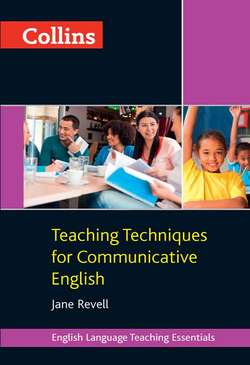Читать книгу Collins Teaching Techniques for Communicative English - Jane Revell - Страница 11
1.4 Teaching communicative competence
ОглавлениеThe crucial question is how to bridge the gap between linguistic competence and communicative competence, how to develop a smooth transition between ‘skill-getting’ and ‘skill-using’.[1:7] In 1973 Wilga Rivers warned that a schizophrenic situation can develop between these two types of activity: in ‘skill-getting’ the emphasis is on the going, not on the destination, whereas in ‘skill-using’ students are aiming at the goal of communicative competence.
The gap is so difficult to bridge because the classroom environment by its very nature makes genuine communi-cation extremely elusive: as we have already said, com-munication stems from necessity, and this element is usually absent in a classroom situation. Students often know in advance what they will say and what everybody else will say too. Everybody (including the teacher) asks questions to which they already know the answer:
T (Referring to a picture or a text) Ask what Johnny was doing at 3 o’clock yesterday.
S1 What was Johnny doing at 3 o’clock yesterday?
S2 He was sitting under a banana tree.
Nobody is exchanging any information, and consequently nobody really needs to listen to what is being said. The element of choice talked about in the last section is missing – there is too much control, there are no surprises.
Necessity, in the form of doubt, of unpredictability, of an information gap can, however, be created in the classroom by the use of activities where the participants are only in possession of part of the total information. Students then have a certain amount of choice in what to say, they ask questions because they don’t know the answer, and they have a reason for listening to one another.
‘Jigsaw’ listening or reading – an idea pioneered by Geddes and Sturtridge in the 1970s[1:8] – is one way of providing an information gap. Each student, or group of students, has one section of the whole tape or text, or certain bits of information that the others don’t have, and they must swap ideas and information in order to discover the whole.
Activities where one person, or half the class, has all the information, and the rest none, also make for authentic communication: those in the know must give instructions to those in the dark. Someone, for example, might have a geometric design and must give the others precise instructions for drawing exactly the same thing. Or, using Lego, one group of students could give another instructions to make a specific model.
Practical exercises which can be recorded and compared with a native speaker’s performance – scientific experiments, making things, assembling component parts of a puzzle, describing the differences between a corkscrew and a bottle-opener etc., can also help learners to gradually build up a ‘native speaker-type intuition’[1:9] (though they are not necessarily easy to organise in a traditional classroom set-up).
Sandra Savignon way back in 1972[1:10] took a slightly more radical view. She felt that experience in ‘authentic’ communication should not be delayed until the learner has a basic set of grammatically correct sentences. Trial and error learning should be used straight away: skill-getting is achieved through skill-using. Her students (English speakers learning French) were introduced to simple kinds of role-play activity very early on. They would enact a situation in English on greetings, for example, watch the same situation enacted in French by native speakers, and then discuss the differences. They then would re-enact the situation in English using French gesture before moving on to try it entirely in French (verbally and non-verbally). Needless to say they had to learn a lot of useful expressions – ‘Je ne comprends pas’, ‘Comment dit-on …?’, ‘Eh bien, … ’, ‘truc’, ‘machin’, etc. – right from the start.
What I would suggest for bridging the skill-getting and skill-using gap are activities where learners are playing a part in situations which are not predictable – e.g. role-play (see Chapter 4, ‘Playing a Part’).
